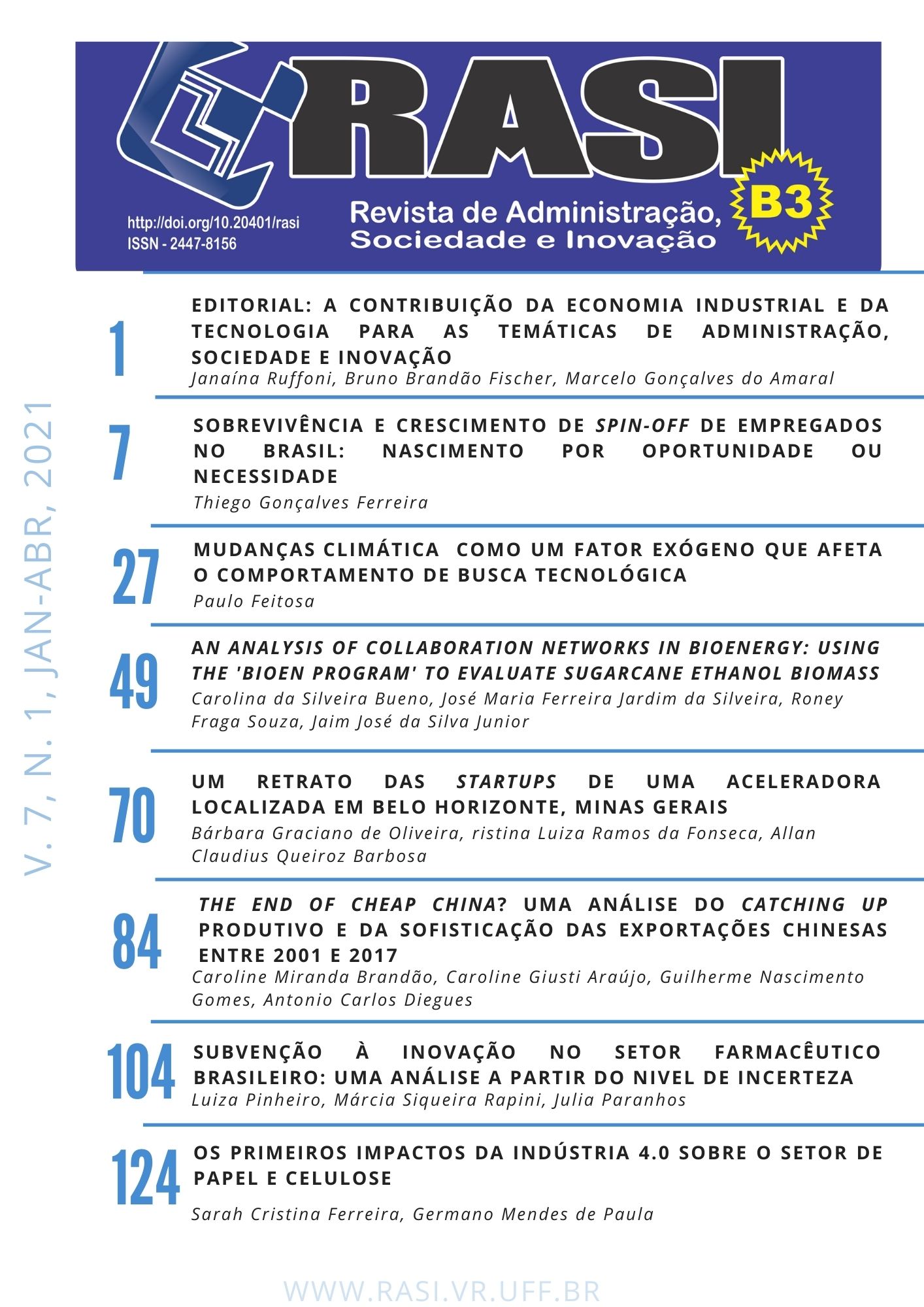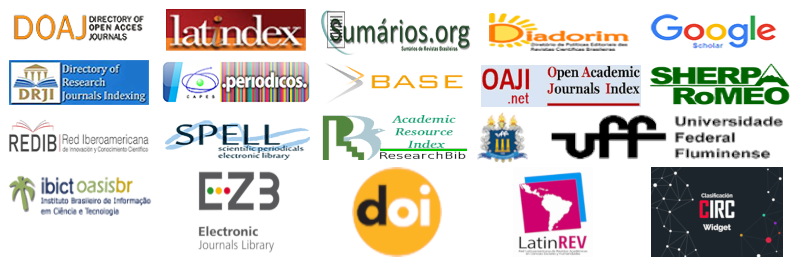The End of Cheap China?
An Analysis of the Productive Catching up and the Sophistication of Chinese Exports between 2001 and 2017
DOI:
https://doi.org/10.20401/rasi.7.1.521Keywords:
China, Comércio Internacional, Margens de comércio, Índice de preços, Estrutura produtivaAbstract
This paper aims to evaluate how the changes in the Chinese productive structure impacted the prices of industrial goods exported by the country between 2001 and 2017, considering, for this, price an explanatory variable of the quality of exports. Methodologically, it is proposed to calculate the intensive and quality margins according to Hummels and Klenow (2005) for sector groups categorized by types of technology (intensive in scale, differentiated and based on science). As a result, the analysis of scale-intensive, differentiated and science-based sectors signals that there is a virtuous process of Chinese technological and productive transformation as there is a general increase in the importance of Chinese exports in third markets, via an intensive margin. However, the export quality index, represented by the price index, is in a lower position compared to the main economies in terms of productive and technological development.
Key-words: China. International trade. Trade margins. Price index. Productive structure.
Downloads
References
Referências bibliográficas
ACIOLY, L. China: uma inserção diferenciada. Rev. Economia política internacional: uma análise estratégica [S.l.], n. 7, out./dez. 2005. Disponível em: <http://goo.gl/j3zMdr>.
AIGINGER, K. Measuring the intensity of quality competition in industries. WIFO. Quarterly. 2001. Disponível em: <http://goo.gl/B9KgJy>.
ARCHIBUGI, D.; MICHIE, J. Technical change, growth and trade: new departures in institutional economics. Journal of Economic Surveys, v. 12, n. 3, p. 313-332, 1998.
BORBÉLY, D. EU export specialization patterns in selected accession and cohesion countries: Tough competition on the EU15 market. Papeles del Este, v. 9, 2005.
CASSIOLATO, J. E. As políticas de ciência, tecnologia e inovação na China. Repositório do conhecimento do IPEA. Boletim de Economia e Política Internacional, 2013.
CASSIOLATO, J. E; PODCAMENI, M. G. B. As políticas de ciência, tecnologia e inovação na China. In: China em transformação: Dimensões econômicas e geopolíticas do desenvolvimento. IPEA, 2015.
CIMOLI, M.; DOSI, G.; NELSON. R. R.; STIGLITZ J. Instituições e políticas moldando o desenvolvimento industrial: uma nota introdutória. Revista Brasileira de Inovação, Rio de Janeiro, vol. 6 (1), 2007.
CROTTY, J. The Effects of Increased Product Market Competition and Changes in Financial Markets on the Performance of Nonfinancial Corporations in the Neoliberal Era. University of Massachusetts, Amherst. October 11, 2002.
EUROPEAN CHAMBER. China manufacturing 2025: Putting industrial policy ahead of market forces, 2017. Disponível em:< http://docs.dpaq.de/12007-european_chamber_cm2025-en.pdf>. Acesso em: 20 maio 2018
FONTAGNÉ, L.; GAULIER, G.; ZIGNAGO, S. Specialization across varieties and North–South competition. Economic policy, v. 23, n. 53, p. 52-91, 2008.
GAO, Y.; WHALLEY, J.; REN, Y. Decomposing China's export growth into extensive margin, export quality and quantity effects. China Economic Review, v. 29, p. 19-26, 2014.
GOMES, G. N. Catching up ou falling behind? As transformações da estrutura produtiva brasileira em comparação a indústria internacional entre o período de 1995 a 2014. Dissertação de mestrado apresentada ao Programa de Pós-Graduação em Economia, na Universidade Federal de São Carlos – campus Sorocaba, 2017.
GOMES, G. N.; SILVA, R. O. Diversificação e qualidade das exportações de manufaturados no comércio mundial. Revista de Economia Mackenzie, v. 17, n. 1, p. 61-91, 2020.
HALLAK, J. C. Product quality and the direction of trade. Journal of international Economics, v. 68, n. 1, p. 238-265, 2006.
HAUSMANN, R.; HWANG, J.; RODRIK, D. What you export matters. Journal of economic growth, v. 12, n. 1, p. 1-25, 2007.
HIRATUKA, C; CUNHA, S.F. Qualidade e diferenciação das exportações brasileiras e chinesas: evolução recente no mercado mundial e na aladi. IPEA. Brasília. Junho de 2011. Disponível em: <http://goo.gl/iqjvP7>.
HUMMELS, D.; KLENOW, P. J. The variety and quality of a nation's exports. American Economic Review, v. 95, n. 3, p. 704-723, 2005.
KALDOR, N. Causes for the slow rate of growth in the United Kingdom. Cambridge: Cambridge University Press, 1966
LARDY, N. China: The Great New Economic Challenge? Institute for International Economics, Washington, DC, 2004.
LAZONICK, W; SULLIVAN, M. Maximizing shareholder value: a new ideology for corporate governance. Economy and Society Volume 29 Number 1 February 2000: 13–35.
MASIERO, G.; COELHO, D. B. A política industrial chinesa como determinante de sua estratégia going global. Revista de Economia Política, vol. 34, nº 1 (134), pp. 139-157, 2014.
MILARÉ, L.F.L. O processo de industrialização chinesa: uma visão sistêmica. 2011. 176 f. Dissertação (Mestrado em Economia) – Universidade Federal de São Carlos, Campus Sorocaba.
NASSIF, A. Há evidências de desindustrialização no Brasil? Brazilian Journal of Political Economy, vol. 28, nº 1 (109), pp. 72-96. 2008.
NONNEMBERG, M. J. B. Participação em cadeias globais de valor e desenvolvimento econômico. Boletim de Economia e Política Internacional. BEP. n. 17. 2014.
NONNEMBERG, M. J. B.; MESENTIER, A. Is China only assembling parts and components? The recent spurt in high tech industry. Revista Economia Contemporânea. Rio de Janeiro, v. 16, n.2:.287-315. 2012.
OECD. Structural Adjustment and Economic Performance. Paris: Organization for Economic Cooperation and Development. 1987.
OECD. Trade in Value Added. Disponível em:< http://stats.oecd.org/index.aspx?r=59951&erroCode=403&lastaction=login_submit#>.
PAVITT, K. “Sectoral patterns of technical change: towards a taxonomy and a theory”. Research Policy, v. 13. p. 343-373, 1984
PINTO, E.C. O eixo sino-americano e as transformações do sistema mundial: tensões e complementaridades comerciais, produtivas e financeiras. In: LEÃO, R.P.F; PINTO, E.C.; ACIOLY, L. (Org.). A China na nova configuração global: impactos políticos e econômicos. Brasília: IPEA, 2011. Capítulo 2. Disponível em: <http://goo.gl/mhRHB6>.
RODRIK, D. What’s so special about China’s exports? NBER, n. 1947. p. 1-27, 2006. Disponível: <http://goo.gl/MZic55>.
SARTI, F.; HIRATUKA, C. Indústria mundial: mudanças e tendências recentes. Texto para discussão. IE/UNICAMP. n. 186, dez/2010.
SCHOTT, P. Across-product Versus Within-product Specialization in International Trade. The Quarterly Journal of Economics. [S.l.], v. 119, n. 2, p. 646-677, May 2004.
SCHOTT, P. The relative sophistication of Chinese exports. Yale School of Management. December 2008. Disponível em: <http://goo.gl/v1B2XI>.
TRADEMAP. Trade statistics for international business development. 2017. Disponível em: < http://www.trademap.org/Index.aspx>.
WORLD BANK. Development Data. Vários dados. Disponível em:<http://databank.worldbank.org/data/views/reports/tableview.aspx>.
Downloads
Published
Issue
Section
License
Copyright (c) 2020 Review of Administration, Society and Innovation

This work is licensed under a Creative Commons Attribution 4.0 International License.
RASI, in accordance with Law No. 9,610 of February 19, 1998, which amends, updates and consolidates Brazilian copyright law and makes other provisions, adopts the following conditions of the Copyright Assignment:
1. RASI maintains, with the transfer of copyrights, the possession of rights over the content published;
2. The author retains his moral rights of the content, including the right to be identified as the author whenever the content is published;
3. Despite the attribution of copyright, the author retains the right to reuse the material in future collections of his own work without encumbrance. The acknowledgments of the previous publication in the RASI are the only requirements in such cases;
4. The author may make photocopies of the content, or distribute it by electronic mail or fax, provided that they are intended for their own classes and for the purpose of meeting research objectives, provided that: (a) such copies are not resold and (b) reference to the original source of the publication and the name of the RASI are clearly indicated on all copies made of the document.











